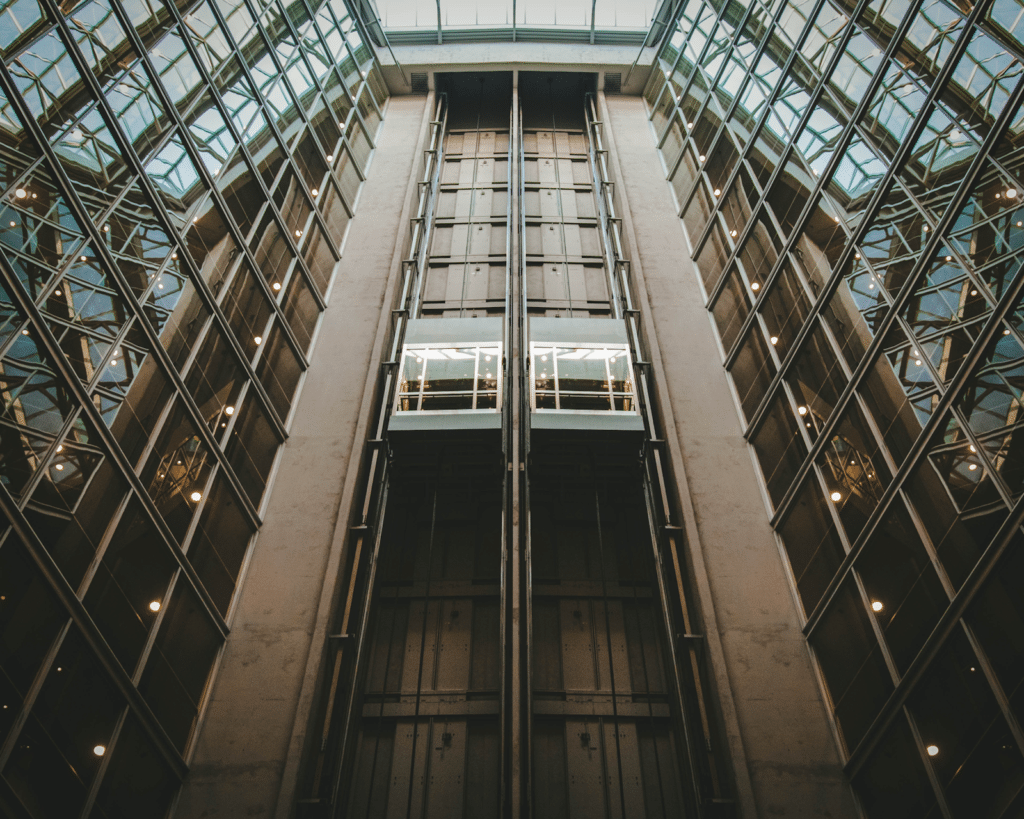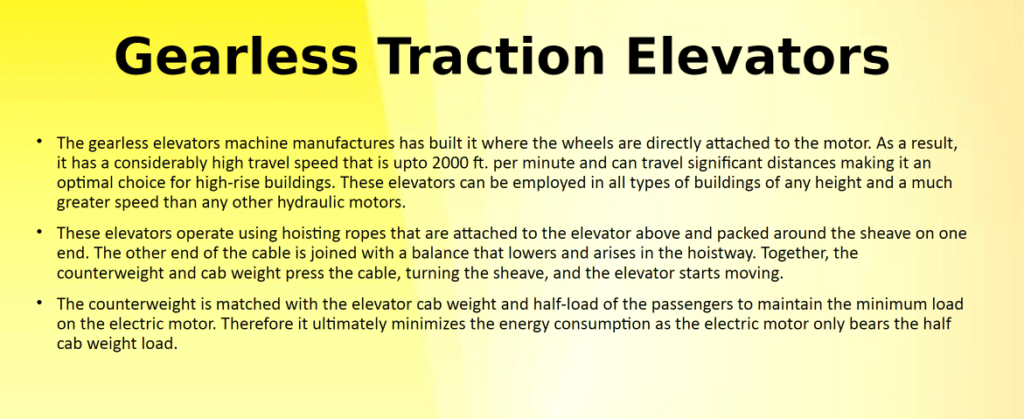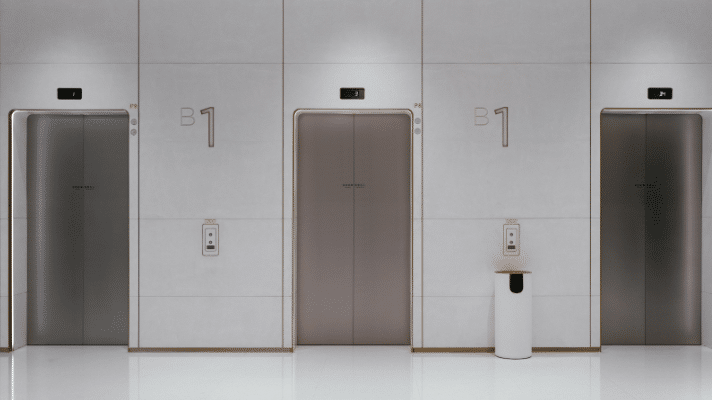
Elevators or lifts are significant intermittent consumers of electricity. The instantaneous power usage during passenger transport may be a thousand times greater than during standby.
Because loads, direction, and duration vary depending on the trip, each one has a somewhat distinct power profile. This characteristic makes it difficult to analyse the immediate power requirement of individual lifts or lift groups. As a result, it is sometimes unclear how much energy these vertical transit systems will ultimately use.
The issue with this is as companies strive to become more eco-friendly, we really need to be more clear about the energy consumption of passenger lifts in both residential and commercial buildings.
In a three-story office building, a typical hydraulic elevator requires 3,800 kilowatt-hours of energy annually, according to data provided by the elevator manufacturer Kone.
However, different types of lifts will of course have different amounts of electricity consumption. Let’s take a look at the lift power consumption for the most common lift types.
Types of energy efficient lifts and their energy consumption
So what is a typical lift energy consumption? Unfortunately this question isn’t that easy to answer. It really depends on a significant number of variables such as:
- Number of people using the lift
- Hydraulic or traction lift drives
- Geared or gearless
- Braking technology
- Acceleration
- Can the lift plot the most energy efficient route?
Recent research has found that lift velocity and acceleration are the leading factors influencing energy performance and consumption, however, this still doesn’t answer the question of how much energy a lift will use, and which is the most efficient.

Hydraulic lifts
For instance, in hydraulic lifts, a lift requires significantly more force to ascend than to descend. (These systems are frequently used in structures with seven stories or less.)
As we mentioned above, in a three-story office building, a typical hydraulic elevator requires 3,800 kilowatt-hours of energy annually, equating to 10.4 kilowatt-hours in lift power consumption per day.
Hydraulic lifts are widely thought to be more energy efficient, but of course there will always be energy consumed when operating a machine of that size.
Heat must be removed by the building’s cooling system while the lift descends the shaft at a predetermined speed due to friction created by oil flowing through the hydraulic valves. This generally means that the energy efficiency is determined by how far the lift has to travel.
Geared traction lifts
Counterweighted pulleys are used to raise and lower the cars in the traction systems seen in taller buildings.
As a complete car weighs significantly more than the counterbalance, moving it up from the ground level takes a large energy input.
On the other hand, a fully loaded car moving downward is so much heavier than the counterweight that it can move with little assistance. A full car going up consumes more energy than a full car going down, and an empty car going down uses more energy than an empty car going up in a typical midrise or high-rise office structure.
Compared to hydraulic elevators, traction elevators have been sown to use less energy. One study shows that traction elevators use from 14 to 270 kilojoules (kJ) for a four-floor ride, while hydraulic elevators use over 400 kJ.

Gearless elevators
Although technically a type of traction lift, the gearless lift is yet another form of energy-efficient lift.
Because they don’t need pulleys or gears, gearless lifts are more effective. They can travel at great speeds and are also incredibly quiet and smooth. However, as you can see in the figures above and below, gearless lifts are often not as efficient as geared elevators.

How much energy does a lift use?
It is estimated that a conventional passenger lift requires 3750 watts of power when it is in standby mode and up to 15,000 watts when it is, with a load of 4-6 people.
Accordingly, an average traditional lift requires 0.21 kilowatt-hours of electricity per hour when it is not in use and up to 0.83 kilowatt-hours when it is.
As we discussed above, the lifting system used can have an impact on how much energy it consumes. For instance, hydraulic lifts consume more energy than those operated by electricity. Additionally, high-speed lifts use roughly 50% more energy than low-speed lifts.
The amount of energy a lift needs is also influenced by its size. Due to the additional weight it must move, a larger lift will require more energy than a smaller one, so make sure you keep all of these factors in mind when assessing the power consumption of your lift system.
Why should we care about how much electricity a lift uses?
We constantly look for methods to be more energy-efficient as a society. While there are some significant changes we can make, such as converting to hybrid or electric vehicles, there are also smaller ones that can have a significant impact.
Increasing the energy efficiency of our lifts is one of those minor adjustments. Although you might believe that lifts consume little energy, they actually can consume a lot, especially if they aren’t operating effectively.
So, why should you care about making your elevator more energy efficient?
Here are some reasons:
- It saves money
Taking the time to modernise your elevator technology and make it more energy efficient ultimately leads to lower costs and energy bills in the long run.
- It’s eco-friendly
If your goal is to lower the annual energy consumption of your building, installing an energy-efficient lift is probably the best way to go. You’ll be helping to reduce pollution and greenhouse gas emissions too!
- Your lift will last longer
Servicing your lift regularly will have an impact on how energy efficient it is. It will last longer and hopefully require fewer repairs in the future.
Looking for energy-efficient options for your lift?
We hope this blog has answered some of your questions in regards to how much power a lift uses and how you can make a lift more energy efficient.
Make sure you do some research before you purchase a lift, a modern and efficient lift could be the best investment you ever make!
In the UK, Future Lift Services are specialists in lift installation, maintenance, and modernisation for all kinds of commercial and residential establishments. With more than 25 years of expertise, we are confident that we can give you a high-quality service that meets your unique needs and expectations.
Get in touch with us today to find out more about our energy efficient lift services or to request a free, no-obligation quote! We are a London and Essex based lift company with a team of experts to help you.
Lift power consumption FAQs
Which type of elevator uses less power?
Traction lifts and hydraulic lifts differ significantly in how they move the cab. In traction lifts, traction steel ropes or belts on a pulley system are used to raise and lower the cab. Traction lifts require less energy than hydraulic systems.
How much power does a lift use?
It is estimated that a typical passenger lift uses about 3750 watts of power when it’s idle, and up to 15,000 watts when it’s carrying a full load.
Is an electric elevator better than hydraulic?
Since electric lifts don’t rely on valves and hoses, leaks and excessive emissions are significantly less likely to occur. The piston and compression involved with hydraulic lifts cause some instability or jerkiness in their movements. Electric motors, in contrast, are far smoother and enable more accurate movement.
Will a shaftless lift produce less CO2 than a lift with a shaft?
Depending on the construction, a shaftless lift could be much more eco-friendly than a standard passenger lift. However shaftless elevator work could also bring about other costs such as materials and electronics as they do require a more specific approach.

